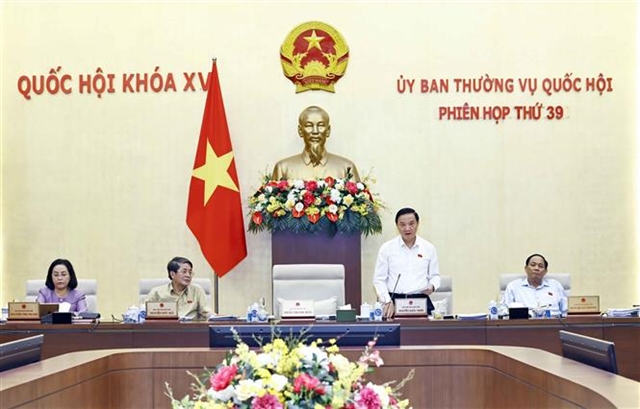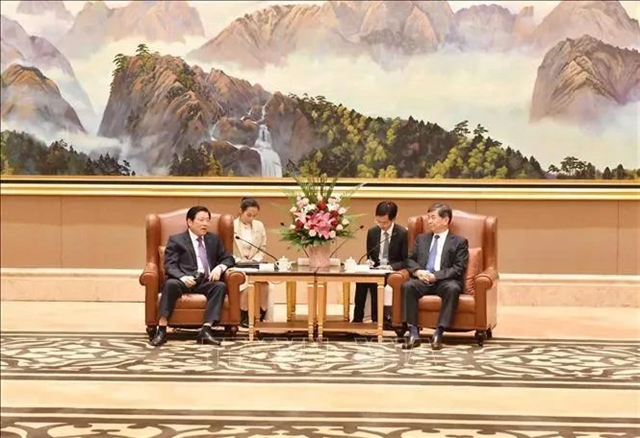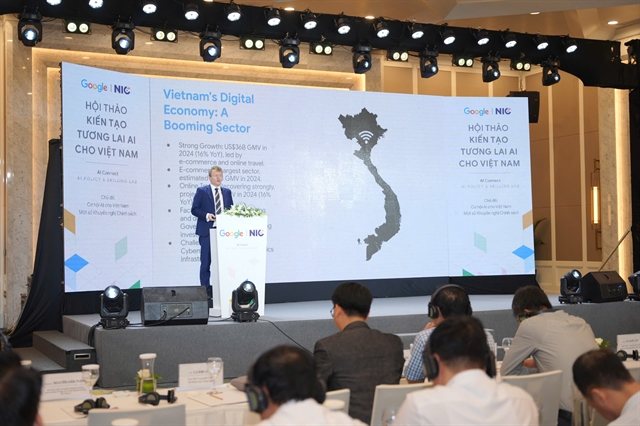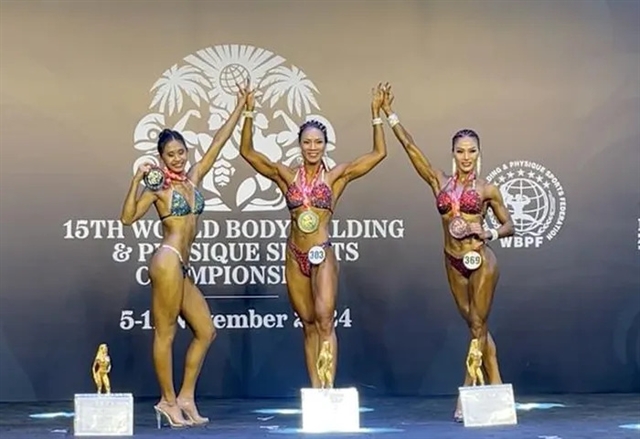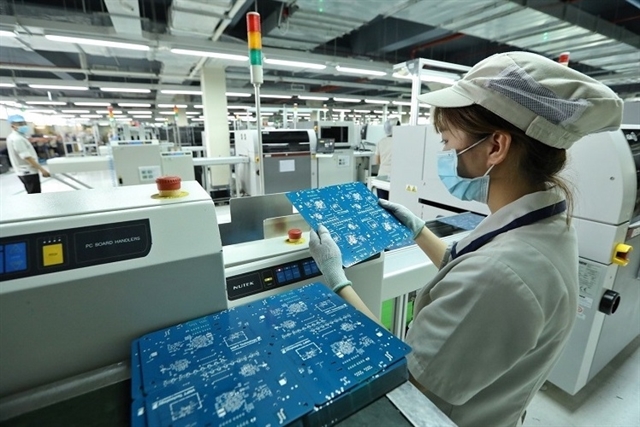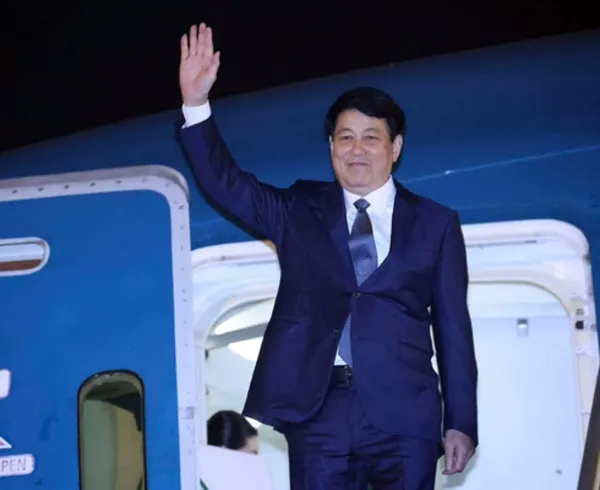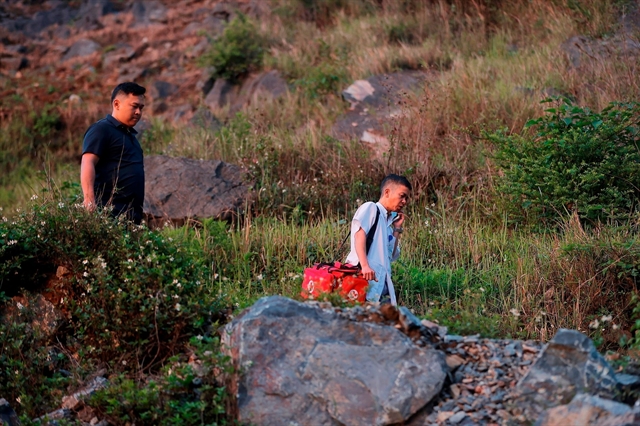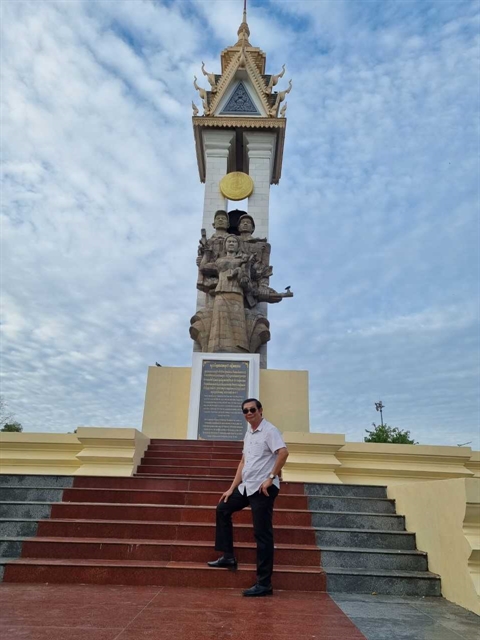 Society
Society
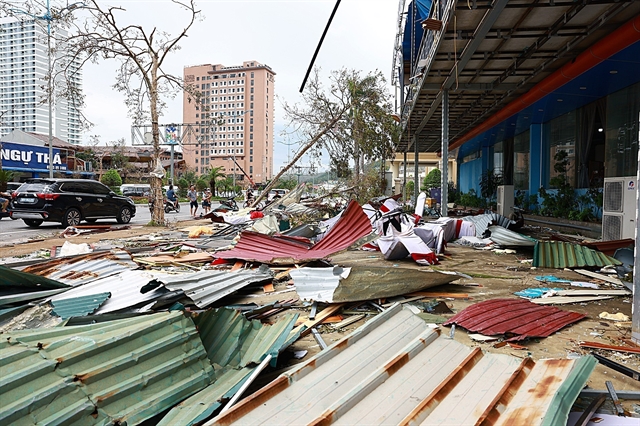
The 45th anniversary of the Vietnamese Volunteer Army’s assistance to the Cambodian people to overthrow the Pol Pot genocidal regime for a new life
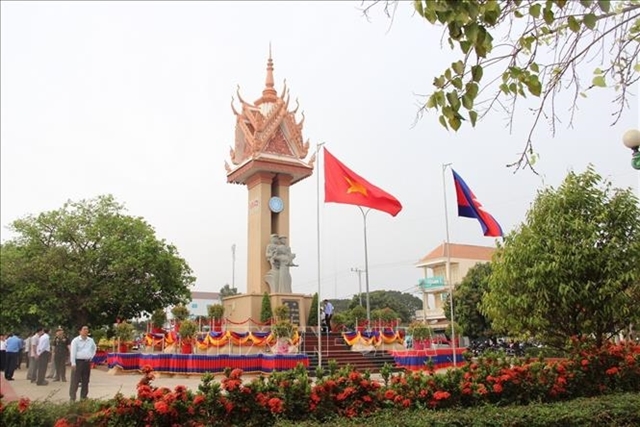 |
| A Việt Nam - Cambodia Friendship Monument was set up in Kampong Cham Province by the Mekong River. Twenty two monuments commemorating the friendship have been established in Cambodia. VNA/ VNS Photo |
On the Cambodian paths
In early November 1978 when I was working in the Hà Nội Bureau of Vietnam News Agency (VNA), Đỗ Phượng, then VNA Deputy General Director sent for me. I met him at his residence close to the head office. Sitting by a small table, he suddenly asked me:
- Do you mind going to Cambodia? Something big is about to happen there and we don’t have much time. There will be big operations on the battlefield. We must cover all the information from the operation, while at the same time, help our friends there build their own news agency. Our team in B2 (the southern provinces) will take the major responsibility and only a few will come in from Hà Nội. You have the advantage of previous experience as a battle reporter.
From that moment, I only had merely a week to get ready. Apart from rearranging family affairs, I tried to find out more about Cambodia, which I barely had any interest in then. To my surprise, there was almost nothing about it in our libraries and archives. Researching a close neighbour with so many complex relations based on so little literature was something to think of.
Our team from Hà Nội was led by Trần Hữu Năng, then Chief of Domestic News Board. As we went South, Năng also looked after the general affairs of the expert team. The expert team also had Nguyễn Bá Ngạc who fought for years in the southern battles and had extensive knowledge about Cambodia; Văn Tường, a French specialist of AVI (French service of VNA); Văn Sắc, an experienced cameraman; Vũ Duy Thông and I. That morning, Hà Nội was so cold. The flight was early in the morning and we left our homes when it was still dark. I would never forget that morning when I had to carry my backpack alone to the car. My wife had to take care of the small children before cycling a few dozen kilometres to her school.
Once we landed in Hồ Chí Minh City, we came to know the urgency of the situation. All the preparatory steps for the big operation on the entire frontier were being made along with the political developments. A few days after our arrival, the National United Front for the Salvation of Kampuchea (FUNK) was born along with the Kampuchea armed forces and other civil organisations. The Kampuchea News Agency (SPK) was also established with Chey Saphon as its first general director.
I would never forget my first meeting with General Director Chey Saphon. He was of middle age, not tall, with a slightly heavy build and dark complexion. The man was gentle and fluent in Vietnamese. In his first meeting with us, the Vietnamese experts, he inspected the newly designed logo of his SPK agency and the announcement of the establishment of SPK to be made to the domestic and international audience. He was frank, telling us that he was not a journalist but came from a political commissar role. He accepted this role under the order of the revolution. SPK initial staff was weak and as such, he asked the Vietnamese friends to help as best they could. Then he gave each of us a Cambodian name to memorise.
Trần Hữu Năng, on behalf of the team said we were doing our international duty and helping SPK was also one of VNA’s duties. We would do our best with SPK and our Cambodian friends to overthrow the Pol Pot regime and save the country from the genocidal threat and build a new life. Năng also emphasised that as we had little understanding of Cambodia, we hoped to receive the assistance of our friends here to be able to fulfil our duties.
In our first days in Hồ Chí Minh City, we stayed right in the two-storey building to the left of our city bureau. That building is now demolished to give space to the ITAXA Printing House. Trần Hữu Năng, Bá Ngạc, Văn Tường, Văn Sắc, Vũ Duy Thông and I slept right on our working tables and had meals in the agency’s canteen. Trần Hữu Năng directly looked after all affairs before Đỗ Phượng, Deputy General Director, took over when he flew in from Hà Nội. In the evenings, we would gather for tea and chat. So much fun. Ngạc would recall his time in Cambodia when working in R (base of the Southern Central Bureau of the Party) during the resistance against the Americans. Năng recalled his time working in the Beijing bureau and Văn Tường talked of his time as French specialist and his professional experience. All the stories helped us prepare better for our future work.
Apart from the team from Hà Nội, the key personnel were taken from B2 comprising those present here since the anti-America resistance in the Liberation News Agency and then covering the news of the Southwestern border war in recent years like Phạm Nhật Nam, Vũ Xuân Bân, Lê Cương, Thanh Hải and so on. To prepare for the operation, the agency formed reporters into small groups to follow the army wings. Vũ Duy Thông and Văn Hiền went with Army Corps No 2 to cover its movement from Kiên Giang to Takeo and Kampong Som. Phạm Nhật Nam and Thanh Hải went with Army Corps No 3 to cover its movement from Phước Long to Kampong Cham and Seam Reap. Đăng Chiến and Hoàng Ba followed the army toward Kratie. Lê Cương and I followed Army Corps No 4 to Svay Rieng and Kandal. I took charge of this group, which also had Thu, a driver from Hà Nội. By mid-December, all of us quickly studied the field situation and moved on to our respective locations. We all were assigned to military units to allow us prompt movement in the other country. The deployment of the military wings promised the full strongest forces on the entire frontier. To us, there were so many concerns due to the alien land, the fierce battles and hardships in that country. But the only thing we could do then was to encourage each other to fulfil our duties. Lê Cương, a handsome and talented Hà Nội photographer, was humorous and agile, quick in everything. Thu, the driver was small but stubborn in hard, dangerous situations. Though we just came to know each other, we felt close almost immediately. My only concern then was that we neither had any radio nor telegrapher in our group, making the communication of information back to the headquarters all the more difficult.
We loaded our car with all the necessary foodstuff and gear sufficient for battle conditions. The most essential items were rice and petrol. Thu made a metal frame at the back of the car to carry four extra 25-litre cans of petrol because without it, we could not do anything. Looking at the 4 cans of petrol at the back of the small Jeep, we felt uneasy. On the battlefield, just a small bullet could blow us all up. In Cambodia, there were so many landmines of the Pol Pot forces. Just hit one and we could turn into ashes in the blink of an eye. That worry showed one difference of this battle: our forces would not operate in the homeland where they had the support of the people and their dearest ones. This time, we just learned a few simple sentences in Khmer. It would be tough when we went out to collect information and interview locals. Yet we had no other choice.
We moved on to the base of Army Corps No. 4 near Tây Ninh. The township was racked after a few years of border war. Artillery shells from the Pol Pot forces still fell on it. We dropped by our local bureau and visited Bà Đen Mount, a place quite new to me and then went to the Army Corps headquarters, not far from the border with Cambodia. Lê Cương knew this area quite well so we did not have any problems finding the way. We only felt the smell of war along the whole border line, a feeling we would not find just by sitting in Hà Nội. To the people of this border area, from the anti-American resistance to date, they had yet to find a single day of peace. Houses, temples, civil constructions were damaged or destroyed. The painful truth was that the bullets came from those we once saw as comrades and friends, shouldering us in the resistance war that bore so many still mourned for their deaths. History has many illogical things, but if we look into the processes, we could still find the logic behind. As we recalled the Spring of 1975 and after the liberation of the South, no one could imagine such developments.
Colonel Ba Cúc, Chief of the Army Corps's Political Commission greeted us at the entrance. I was impressed with his gentle and somehow artistic outlook. With a warm, gentle and cordial voice, he brought to us a sense of trust and warmth. He said the Commission was glad to have us and hoped that we would find it a home, committing to help us with all the difficulties during our operations and provide us all it could within its capabilities.
Ba Cúc spread out a map on the table and introduced the situation, possible military directions and the overall duties of the Army Corps. We listened and thought of possible scenarios on our movements forward. In all directions, we were moving along with the Army Corps that was closest to Phnom Penh. By road, it would just be 100km from Svay Rieng to Pray Vieng and Kandal. Core to this movement was perhaps the Niek Luong ferry terminal, which was quite large. On the other side of the border were Pol Pot’s main forces and divisions. They were the enemy’s most skilled fighters that killed so many of our people in this border area. The Pol Pot forces also knew the importance of this front and as such, deployed their units both horizontally and vertically. Apart from the artillery and infantry units with strong firepower, the worst were landmines. On all the routes, one sure thing was the heavy loaded network of landmines to prevent the movement of our forces when big battles erupted over the border.
After the meeting with Ba Cúc, we went out to introduce ourselves to the cadres and soldiers of the Commission and Army Corps, including its own reporters, artists and performers sent in from the higher command, like writers Nguyễn Chí Trung, Xuân Đức or Trần Đăng Khoa. The battlefield drew us together and in only a few days, we already became like a family. At the same time, Lê Cương and I were both field reporters during the war and as such, we quickly felt close with these soldiers, especially those who worked the same journalist job like us. Those few days before the big operation were short but full of fun and cheer as they helped us mingle and start our professional work with the team of Army Corps No. 4, alias the Cửu Long Army Corps, on the key offensive direction of the operation.
The operation started on December 25, 1978. During the night, the sound of 130mm artillery pieces could be easily detected by those familiar with the battlefield due to loudness. The offensive units of the Army Corps moved along the national roads and other directions with little resistance. From Bến Sỏi - Gò Dầu in Tây Ninh, we marched on with our brothers in the Political Commission to cross the border at the Pray Vieng sector from the early morning. On our Jeep, there were also writer Xuân Đức and writer Lê Huy Khánh. I recalled our impression when we stepped on Cambodian land. The advancing path during the dry season was dusky and red. Grass was everywhere. A strange and uneasy feeling. For the first time, I marched in a strange land with the Vietnamese volunteer soldiers (not to mention the Trường Sơn Trail during the Việt Nam War). Behind those bushes, there might be guns directed at us. The land beneath our feet could explode anytime from the mines. But in front of us were the villages where our fraternal people were suffering. Behind us were the villages of our dear Homeland unable to see a peaceful day.
We marched on day and night. The battles in front of us were fierce. The team kept close to the national roads and all were ready for battle. Thu carefully drove the car in the tire marks of the vehicle in the front. Lê Cương took his time to shoot his first photos. We felt assured when moving within the Army Corps’s formation. Otherwise, it would be hard to manage in this new land. But I also envisioned scenarios when we had to operate independently if we were to be more effective and active to fulfil our duties. We needed the very first piece of news and photos to send back to our colleagues in B2. On this point, reporters are quite different from writers. Nguyễn Chí Trung, Xuân Đức and Trần Đăng Khoa did not need to rush and calculate the days like us or have to be present on time at key positions to collect materials and photos for the news agency.
On January 1, we crossed Svay Rieng Town, a small township with low houses, coconut farms and palm trees rising to the sky. We saw empty houses and gardens, from Pol Pot’s tactic of ‘emptying to resist’. The road surface was mostly destroyed, preventing us from keeping the pace. Vehicles could not move fast because we had to change gear often due to the cracks. In many places, there were mounds of dirt or rocks, forcing the engineering units to work and clear possible landmines. The gun sounds from the Niek Luong ferry terminal battle were close by. Sudden artillery shells could fall upon us anytime. From the bushes along the roads, rounds of Kalashnikov guns were shot now and then. The Pol Pot forces could not stand head on with the Vietnamese volunteer army and the forces of the FUNK. They could only resort to perfunctory resistance and then withdraw, hiding themselves in the bushes and woods and making sneak shots.
Mid-day January 3, we were marching ahead when the news arrived: our forces had been able to meet the Cambodian people. Everyone got excited. We told each other to get ready. My regret was that none of us knew Khmer while the Political Commission only had a few interpreters. Fortunately, some cadres in the team knew a little Khmer, just enough to communicate. I was startled when noticing the first group of Cambodian people on the road, somewhere between Pray Vieng Town and Niek Luong ferry terminal, close to Preah Neang. They walked in groups, all in dirty black outfits, tired and torn just like emerging from hell. They came from the communes along the road, hiding in the woods at gun sounds and taking the opportunity when Pol Pot’s troops ran away to liberate themselves by running towards the East.
Many of them were exhausted. Some elders could not walk without the help of their relatives. Children fainted on their mothers’ hands. It was so sad to see those innocent faces. At first sight, they seemed reluctant and doubtful to see the Vietnamese soldiers. Perhaps they could not believe these people came to their rescue. But in the army formation there were also soldiers from the FUNK. They accompanied the Vietnamese soldiers to chat and encourage these people. Then they gave out water and rice, treating the sick and wounded, the exhausted; helping them overcome their trauma and showing them the way to a safe place. Only then did we start to see smiles on their faces. The years of living under Pol Pot-ruled communes to them were like living in prison. Thousands of such prisons in this country had kept this entire nation in confinement. Now that the danger had gone, they could return to a hard-to-believe normal life. We stopped before a group of people. A cadre of the Political Commission knowing some Khmer came to our assistance to talk with them.
While the battles continued in the front, a huge amount of work was being done to receive the people, provide medical treatment and food, introduce the revolutionary government’s policies to the people and bring them back to their hometowns. There were so many sad stories. Every family had one or more members who died in the communes during those years. Many were searching in vain for their loved ones. Many died of exhaustion before receiving proper treatment. The stories about the disguised ‘communes’ of Pol Pot’s bizarre model of a ‘clean socialism’ make listeners shudder from this monster in history. We barely understood these stories in the first days because we did not have a good translator at hand. Now, when I recall them, I still feel the horror of that space and remember the terrifying and heavy smell. Later we learned that that smell was from polluted air and water caused by too many deaths. The smell of decomposing corpses accumulated in the surrounding environment, hovering in the air, sticking to one’s breath and water sources, following us in our meals and our sleep all through the time we spent in Cambodia.
At the Preah Neang junction, I met an old woman named Sim. Her home village was Co Rua, not far from Svay Rieng. She was travelling home with her only remaining son Sau Sot. She was nearly 70. Her husband and other children were killed by the Pol Pot troops. I would never forget the image of this thin, white haired and torn woman in black, with her trembling hands covering her face to hide the tears. There were so many others like her here who shared a similar fate.
In another instance, we came across Phon, a native of Ch’tea village at Kampong T’rabeah junction in Svay Rieng. He and some others were listening to Chairman Heng Samrin’s speech and read FUNK’s Political Agenda. In the meantime, FUNK soldiers distributed medicines to the sick. We could not make out that this thin and pale man was already 27. He told us of his joy when rescued by Vietnamese army volunteers and Cambodian revolutionary soldiers. He and his people told us that after retreating from Svay Rieng, the Pol Pot troops killed many and forced others to follow them. They would not allow anyone to bring their belongings along and made them walk under the sun for days. In many places, the people revolted to find their way back home.
Phon also told us that the Pol Pot troops pushed hundreds of people into the Mekong River at a place near the Niek Luong ferry wharf during their flight. We also met Choi, a native of Kday Village. She was holding her child, perhaps less than a year old, hungry in its mother’s hands. Like Sim, eight persons in her family were killed, leaving just the mother and child. Yet amid the pain on her face, there was a ray of hope for a new life that was coming to her and the Cambodian people.
Svay Rieng Town, once a bustling and beautiful township, was now a deserted place. Grass dominated every place and the vacated buildings. No sign of a boat on the Pram River. With the people returning, it slowly gathered its warmth back. We crossed roads with a female publicity team of Svay Rieng Province on their way to work right on the streets of the town. The young girls in their fit uniforms showed all their strength and youthfulness that brought about vitality in this place. Komsa Muon, the team leader, showed clear signs of a joyful return. Svay Rieng was where she was born and grew up until the day the Pol Pot troops entered. By the deserted town market, Komsa Muon said she could not recognise the previous life of the town, but believed it would again regain its bustling and prosperous look, even more than before.
During January 4 and 5, the battles took place along the Mekong River. It was understandable as the big river served as a perfect defensive frontline for the Pol Pot troops. The Niek Luong ferry wharf did not have any bridge nearby. The entire large river ran across the provinces under the Army Corps No. 4’s coverage. All the ferries on the Cambodian side were either destroyed or drawn back to the other bank. This was the last defensive line of the Pol Pot forces before the entrance to Phnom Penh. Pol Pot’s commando forces were also gathered here. That was why our team members became impatient. We had been able to collect excellent materials on the first operation of this Eastern wing, both its military activities and the situation at the newly liberated areas. We met with many people and shot a lot of photos. Pending a clearer picture of the situation, Lê Cương and I discussed our return to Hồ Chí Minh City to archive the information and photos and then get back to Cambodia. We understood that once the information about this operation was released, we would need a lot of timely documents from the newly liberated areas and field operations. From where we were, it would be just half a day trip to Hồ Chí Minh City. After consulting with the Political Commission, we rushed back to Hồ Chí Minh City in the morning of January 6. Xuân Đức and Huy Khánh stayed back to accompany the Commission’s officers. Our preparations for the trip back were made in a hurry. The trip would not be without danger as we would have to pass areas that still harboured some Pol Pot’s remaining troops. But both Lê Cương and I were once field reporters, we understood that the sooner the information reached its destination the better. We rode in one go to Tây Ninh and then on to Hồ Chí Minh City, only having some instant noodles midway. I felt quite concerned for Thu. Since the beginning of the operation till now, he must have been very tired because of the constant travel and movement, lack of proper meals and sleep, with all the dangers around and the tough working environment. Along the way, we continued to take time to note down and shoot new photos of the liberated Svay Rieng and Pray Veng provinces. Thankfully the small Jeep ran well without any major breakdown although its springs were overloaded with the road conditions. At any bump or crack on the road, we were painfully thrown around in the car.
Later that afternoon, we arrived at the Hồ Chí Minh City Bureau. Trần Hữu Năng was so cheerful to see us. We rapidly reported the situation. We were the first group of reporters to bring back the documents. I immediately wrote down all the notes I took on the way of the liberation of the Eastern part of Cambodia. Lê Cương in the meantime developed the films to print his photos and select his own archive and notes. Then all the documents and photos were given to Trần Hữu Năng for further processing. This operation was quite different from those in the anti-American War. All information we gathered must be sent to the Front Command. The Publicity Division would then consider how to use them for the media and communication. It was understandable, as this time, we went out to help. Media issues must be in close coordination with other operations when the international public became quite sensitive.
I still recalled Trần Hữu Năng’s concern and slow voice:
"Just leave the documents to us for further processing. It is good that you made it timely. You can rest for a day and return to the front immediately. We do not have much time."
I knew he took great care of us. He said just a few days but we looked so pale. Yet he was shouldering a heavy responsibility. I reported to him that we would return to the Army Corps immediately the next day and only hoped that Thu could have a full night of deep sleep to regain his strength for the fierce and hard days ahead. VNS
To be continued


